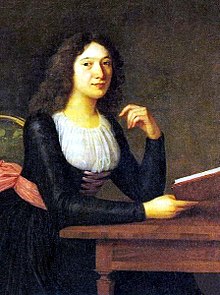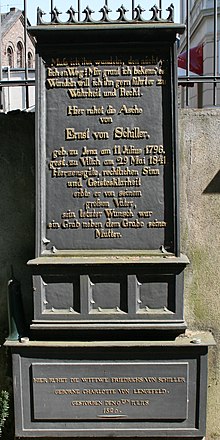Charlotte von Schiller


Steel engraving by Fleischmann after Pecht , around 1859
Charlotte Luise Antoinette von Schiller , née von Lengefeld (born November 22, 1766 in Rudolstadt , † July 9, 1826 in Bonn ) was the wife of the poet Friedrich von Schiller .
Life
She spent her childhood in Rudolstadt, where she grew up with her older sister, the later writer Caroline von Wolhaben (1763-1847). Her father, the Oberlandjägermeister Carl Christian von Lengefeld (1715–1775), died early and left behind the widow Louise von Lengefeld , née, who was completely inexperienced in economic matters . von Wurmb (1743-1823). All reserves were quickly used up and the family ran into material difficulties. So Louise immediately agreed when in 1779 the well-to-do Friedrich Wilhelm Ludwig von Beulwitz asked for the hand of her eldest daughter Caroline.
When the completely penniless Schiller came to Rudolstadt in 1787, both sisters fell in love with him. Schiller returned the affection. Since both Charlotte and Caroline were equally attractive to him and he could not choose either of the two, he considered a three-way relationship. But neither Charlotte nor her mother, who was already taken with the impoverished poet, could warm to this idea. In the summer of 1789, the two sisters took a cure in the luxury and fashion spa Lauchstädt near Halle (Saale), which was then part of the Saxon region . The former home of the sisters Armenhausgasse 5 (today Schillerstraße 5) has been preserved. After Schiller's brief visit to Bad Lauchstädt, Charlotte received the “engagement letter” written in Leipzig . At the end of 1789, shortly before the wedding to Charlotte (1790), Schiller wrote to his fiancée, however: “Caroline brought up more feelings in me than you, my Lotte […]. What Caroline has ahead of you, you must receive from me: Your soul must develop in my love, and you must be my creature. "
On February 22, 1790, Schiller, who was now financially better off, married Charlotte von Lengefeld in the small church in Wenigenjena (now named after him). Soon after the wedding he was able to write: “What a beautiful life I lead now […]. The existence of Charlotte, this lovely, dear being around me, whose whole bliss is lost in mine, spreads a gentle light over my existence. ”The marriage resulted in four children:
- Karl Ludwig Friedrich Schiller (1793–1857), later baron
- Ernst Friedrich Wilhelm Schiller (1796–1841)
- Caroline Luise Friederike Schiller (1799–1850), married. Junot (buried in the Würzburg main cemetery)
- Emilie Henriette Luise Schiller , married. von Gleichen-Rußwurm (1804–1872)
The connection to Caroline von Wolhaben, on the other hand, who achieved literary fame with her novel Agnes von Lilien (1797) and her biography Schiller's Life (1830), increasingly lost importance.
In February 1805 Schiller fell seriously ill; in May he died . Charlotte raised the four children who were twelve, nine, six, and one year old when her father died. In 1821 she visited her son Ernst in Cologne, who was now married here. In 1825 she visited her eldest son Karl in Reichenberg near Backnang , who was just getting married. In the autumn of the same year she moved to Ernst to Bonn . Here she underwent cataract surgery , which she survived well. On July 9, 1826, she suffered a fatal stroke ; two days later she was buried in the old cemetery in Bonn .
reception
Charlotte von Schiller is an indispensable part of Weimar Classicism: Her reputation as a clever and prudent partner of her famous husband can hardly be overestimated. What is largely forgotten is the importance attested in her letters and diaries, which she also had for Goethe and his friend Karl Ludwig von Knebel. Charlotte von Schiller has occasionally been wrongly rated by literary posterity as inconspicuous, boring or even mindless. This impression may have originated from Charlotte von Stein's letters . Goethe's astute and sometimes vicious companion occasionally described her godchild Charlotte, with whom she was in close contact, as a bit simple-minded.
How intelligent Charlotte really was is illustrated by her diaries and her "extensive collection of excerpts" stored in the Weimar archive. In it she not only represents views that testify to great unconventionality and intellectual independence, but also shows the commitment with which she studied all the well-known new publications of her time. In addition to those of philosophy and literature, this also included those of the "scientific fields", which she followed with great interest and assessed with extraordinary expertise, which Schiller and the old Goethe particularly appreciated.
Today the “Neues Schillerhaus” literature and theater museum in Bad Lauchstädt commemorates the stay of the Lengefeld sisters, their encounter with Schiller and Schiller's visit to the Lauchstädter Theater in August 1803.
Works
- Charlotte Schiller: Literary Writings. Edited by Gaby Pailer, Andrea-Dahlmann-Resing u. Melanie Kage. Darmstadt 2016, ISBN 978-3-534-23912-2 .
Letters
- Heinrich Düntzer (Ed.): Letters from Schiller's wife to a trusted friend. Leipzig 1856.
- Ludwig Urlichs (ed.): Charlotte von Schiller and her friends. 3 vols. Stuttgart 1860-1865.
literature
- Jörg Aufenanger: Schiller and the two sisters. Dtv, Munich 2005, ISBN 3-423-24446-1 .
- Eva Gesine Baur : "You have to be my creature". The life of Charlotte Schiller. Hoffmann and Campe, Hamburg 2004, ISBN 978-3-455-09458-9 .
- Gaby Pailer: Charlotte Schiller: Living and Writing in Classic Weimar. WBG, Darmstadt 2009, ISBN 978-3-534-21973-5 .
- Andrea Schütte-Bubenik: An unheard of journey into the time of Goethe. Handbook for culture deprived. Königshausen and Neumann, Würzburg 2009, ISBN 978-3-8260-4104-4 .
- Kirsten Jüngling , Brigitte Roßbeck: Schiller's double love. Propylaen, Berlin 2005, ISBN 3-549-07207-4 (paperback edition: List, Berlin 2006, ISBN 3-548-60650-4 ).
- Christa Rudnik: Literary excerpts from Charlotte von Schillers. A contribution to the history of reception around 1800. An attempt to summarize the sources from the Goethe and Schiller archive. In: In advance of the literature. The value of archival records for an understanding of literature and its history. Edited by Karl-Heinz Hahn . Weimar 1991, pp. 140-147.
- Walter Weber: Karl von Schiller. On the 100th anniversary of the death of the forgotten son of our great poet. In: Schwäbische Heimat , 1957, pp. 96–97.
- Emilie von Gleichen-Rußwurm (Ed.): Schiller and Lotte. 1788, 1789. Cotta, Stuttgart 1856 ( digitized version ).
- Arnold Schlönbach: Schiller's wife . In: The Gazebo . Issue 19-20, 1855, pp. 245-248, 263-265 ( full text [ Wikisource ]).
Radio / theater
- You are mine wherever you are mine. Radio play and drama by Jiří Ort . Produced by Norddeutscher Rundfunk in 2005 with Monica Bleibtreu and Andreas Fröhlich as Charlotte and Friedrich von Schiller and Marlen Diekhoff as Caroline von Wolhaben.
Filmography
- The Beloved Sisters (2014) by Dominik Graf , 139 minutes, Federal Republic of Germany.
Web links
- Literature by and about Charlotte von Schiller in the catalog of the German National Library
- Charlotte Schiller in the Family Tree Wiki
- Collected letters from Friedrich Schiller to Charlotte von Lengefeld in the Friedrich Schiller Archive
Individual evidence
- ↑ cf. Schiller's letter to Charlotte von Lengefeld and Caroline von Beulwitz. November 15, 1789.
- ↑ Andrea Schütte-Bubenik: An unheard of journey into the time of Goethe. Handbook for culture deprived. Würzburg 2009, p. 60.
- ↑ Christa Rudnik: Literary excerpts Charlotte von Schillers. A contribution to the history of reception around 1800. Attempt to summarize the sources from the Goethe and Schiller Archives. In: In advance of the literature. The value of archival records for an understanding of literature and its history. Edited by Karl-Heinz Hahn. Weimar 1991, pp. 140-147.
- ↑ Andrea Schütte-Bubenik: An unheard of journey into the time of Goethe. Handbook for culture deprived. Würzburg 2009, pp. 72-84.
| personal data | |
|---|---|
| SURNAME | Schiller, Charlotte von |
| ALTERNATIVE NAMES | Schiller, Charlotte Luise Antoinette von (full name); Lengefeld, Charlotte Luise Antoinette (maiden name) |
| BRIEF DESCRIPTION | Wife of Friedrich Schiller |
| DATE OF BIRTH | November 22, 1766 |
| PLACE OF BIRTH | Rudolstadt |
| DATE OF DEATH | July 9, 1826 |
| Place of death | Bonn |

